Numerical Investigation of Tar Formation Mechanisms in Biomass Pyrolysis
Abstract
1. Introduction
2. Methodology
2.1. Hydrodynamic Modeling
- A.
- Governing equation.
- B.
- Contact force model.
- C.
- The drag model is presented in Equations (6)–(9):
- E.
- Heat and mass transfer equation.
- E.
- Shrinking core model
2.2. Semi-Detailed Chemical Mechanism
2.3. Case Description
2.4. Experimental Validation
3. Result and Discussion
3.1. Gaseous Product
3.2. Tar Component Formation
3.3. Reaction Rate Analysis
3.4. Particle-Scale Analysis
4. Conclusions
Author Contributions
Funding
Data Availability Statement
Conflicts of Interest
References
- Ding, S.; Yang, X.; Gan, C.; Qiu, T. Discussion on the New Path of Carbon-Negative Aviation Fuel. Aerosp. Power 2022, 6, 16–19. [Google Scholar]
- Gan, C.; Ma, Q.; Bao, S.; Wang, X.; Qiu, T.; Ding, S. Discussion of the Standards System for Sustainable Aviation Fuels: An Aero-Engine Safety Perspective. Sustainability 2023, 15, 16905. [Google Scholar] [CrossRef]
- Nunes, S.M.; Paterson, N.; Herod, A.A.; Dugwell, D.R.; Kandiyoti, R. Tar Formation and Destruction in a Fixed Bed Reactor Simulating Downdraft Gasification: Optimization of Conditions. Energy Fuels 2008, 22, 1955–1964. [Google Scholar] [CrossRef]
- Sharma, A.; Pareek, V.; Zhang, D. Biomass pyrolysis—A review of modelling, process parameters and catalytic studies. Renew. Sustain. Energy Rev. 2015, 50, 1081–1096. [Google Scholar] [CrossRef]
- Dilks, R.T.; Monette, F.; Glaus, M. The major parameters on biomass pyrolysis for hyperaccumulative plants—A review. Chemosphere 2016, 146, 385–395. [Google Scholar] [CrossRef]
- Zhan, X.; Wu, W.; Cui, G. Formation and homogeneous conversion mechanism of biomass pyrolysis tar. Energy Res. Inf. 2019, 35, 125–133. [Google Scholar]
- Cundall, P.A.; Strack, O.D.L. A discrete numerical model for granular assemblies. Géotechnique 1980, 30, 331–336. [Google Scholar] [CrossRef]
- Li, C.; Eri, Q. Comparison between two Eulerian-Lagrangian methods: CFD-DEM and MPPIC on the biomass gasification in a fluidized bed. Biomass Convers. Biorefinery 2021, 13, 3819–3836. [Google Scholar] [CrossRef]
- Oevermann, M.; Gerber, S.; Behrendt, F. Euler–Lagrange/DEM simulation of wood gasification in a bubbling fluidized bed reactor. Particuology 2009, 7, 307–316. [Google Scholar] [CrossRef]
- Ku, X.; Li, T.; Løvås, T. CFD–DEM simulation of biomass gasification with steam in a fluidized bed reactor. Chem. Eng. Sci. 2015, 122, 270–283. [Google Scholar] [CrossRef]
- Song, T.; Wu, J.; Shen, L.; Xiao, J. Experimental investigation on hydrogen production from biomass gasification in interconnected fluidized beds. Biomass Bioenergy 2012, 36, 258–267. [Google Scholar] [CrossRef]
- Ku, X.; Jin, H.; Lin, J. Comparison of gasification performances between raw and torrefied biomasses in an air-blown fluidized-bed gasifier. Chem. Eng. Sci. 2017, 288, 235–249. [Google Scholar] [CrossRef]
- Ku, X.; Shen, F.; Jin, H.; Lin, J.; Li, H. Simulation of biomass pyrolysis in a fluidized bed reactor using thermally thick treatment. Ind. Eng. Chem. Res. 2019, 58, 1720–1731. [Google Scholar] [CrossRef]
- Mettler, M.S.; Vlachos, D.G.; Dauenhauer, P.J. Top ten fundamental challenges of biomass pyrolysis for biofuels. Energy Environ. Sci. 2012, 5, 7797–7809. [Google Scholar] [CrossRef]
- Shafizadeh, F.; Fu, Y.L. Pyrolysis of cellulose. Carbohydr. Res. 1973, 29, 113–122. [Google Scholar] [CrossRef]
- Bradbury, A.; Sakai, Y.; Shafizadeh, F. A kinetic model for pyrolysis of cellulose. J. Appl. Polym. Sci. 1979, 23, 3271–3280. [Google Scholar] [CrossRef]
- Ranzi, E.; Cuoci, A.; Faravelli, T.; Frassoldati, A.; Migliavacca, G.; Pierucci, S.; Sommariva, S. Chemical Kinetics of Biomass Pyrolysis. Energy Fuels 2008, 22, 4292–4300. [Google Scholar] [CrossRef]
- Faravelli, T.; Frassoldati, A.; Migliavacca, G.; Ranzi, E. Detailed kinetic modeling of the thermal degradation of lignins. Biomass Bioenergy 2010, 34, 290–301. [Google Scholar] [CrossRef]
- Faravelli, T.; Frassoldati, A.; Barker Hemings, E.; Ranzi, E. Multistep Kinetic Model of Biomass Pyrolysis; Springer: London, UK, 2013. [Google Scholar]
- Ranzi, A.F.; Debiagi, P.E.A.; Frassoldati, A. Mathematical Modeling of Fast Biomass Pyrolysis and Bio-Oil Formation. Note I: Kinetic Mechanism of Biomass Pyrolysis. Acs Sustain. Chem. Eng. 2017, 5, 2867–2881. [Google Scholar] [CrossRef]
- Ranzi, A.F.; Debiagi, P.E.A.; Frassoldati, A. Mathematical Modeling of Fast Biomass Pyrolysis and Bio-Oil Formation. Note II: Secondary Gas-Phase Reactions and Bio-Oil Formation. Acs Sustain. Chem. Eng. 2017, 5, 2882–2896. [Google Scholar] [CrossRef]
- Debiagi, P.; Gentile, G.; Cuoci, A.; Frassoldati, A.; Ranzi, E.; Faravelli, T. A predictive model of biochar formation and characterization. J. Anal. Appl. Pyrolysis 2018, 134, 326–335. [Google Scholar] [CrossRef]
- Lu, L.; Gao, X.; Gel, A.; Wiggins, G.M.; Crowley, M.; Pecha, B.; Shahnam, M.; Rogers, W.A.; Parks, J.; Ciesielski, P.N. Investigating biomass composition and size effects on fast pyrolysis using global sensitivity analysis and CFD simulations. Chem. Eng. J. 2021, 421, 127789. [Google Scholar] [CrossRef]
- Rapagnà, S.; Jand, N.; Kiennemann, A.; Foscolo, P.U. Steam-gasification of biomass in a fluidised-bed of olivine particles. Biomass Bioenergy 2000, 19, 187–197. [Google Scholar] [CrossRef]

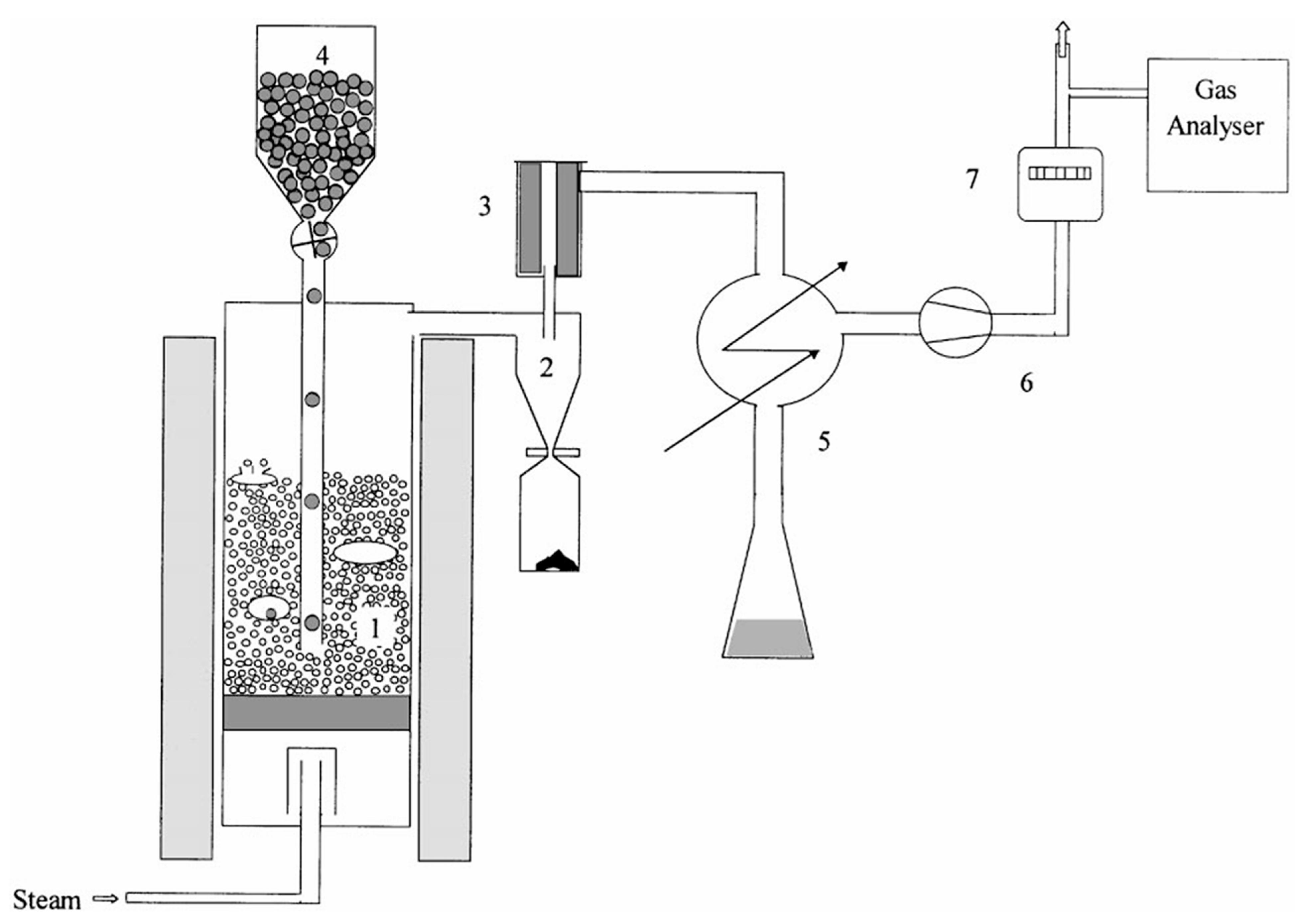


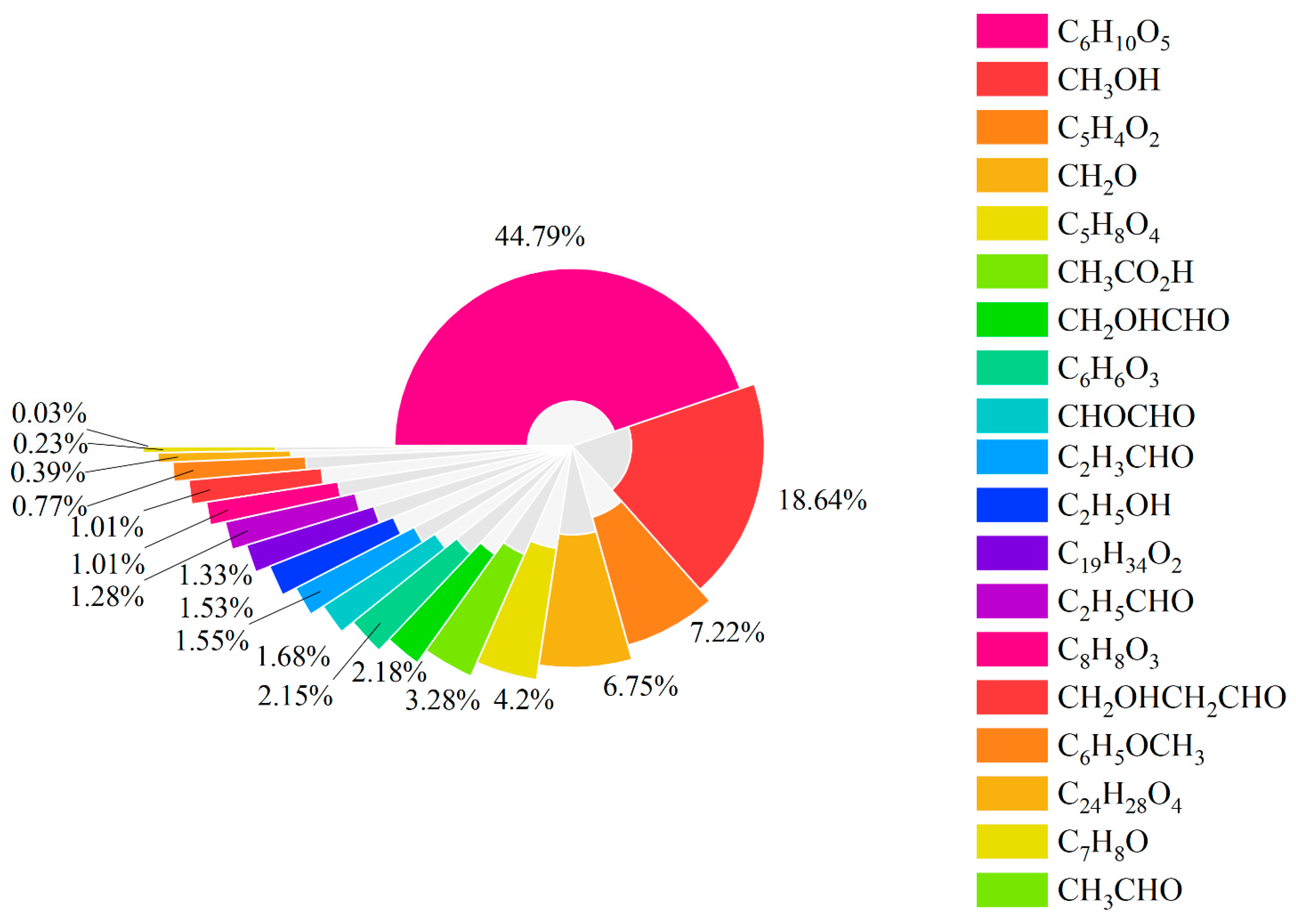
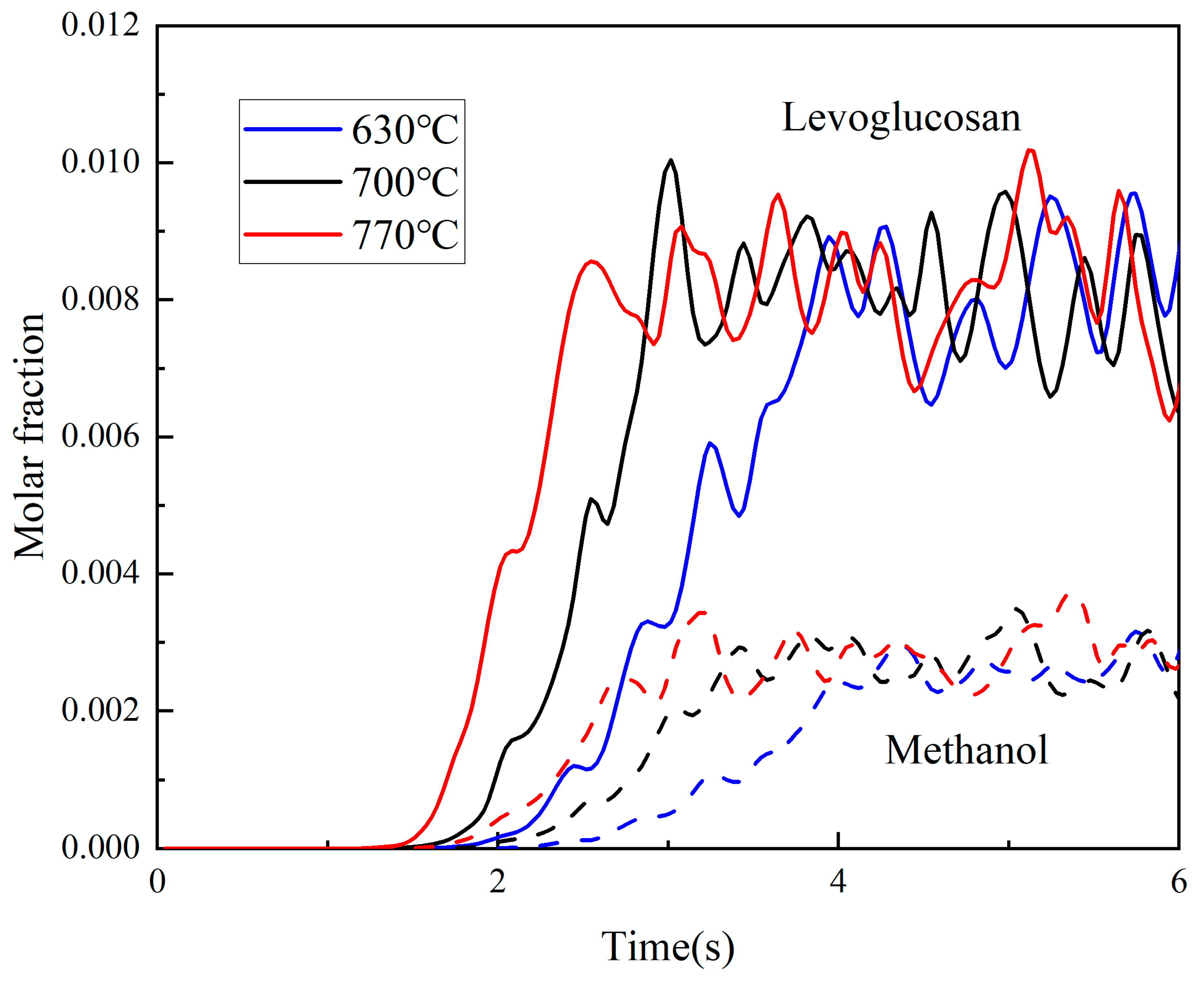
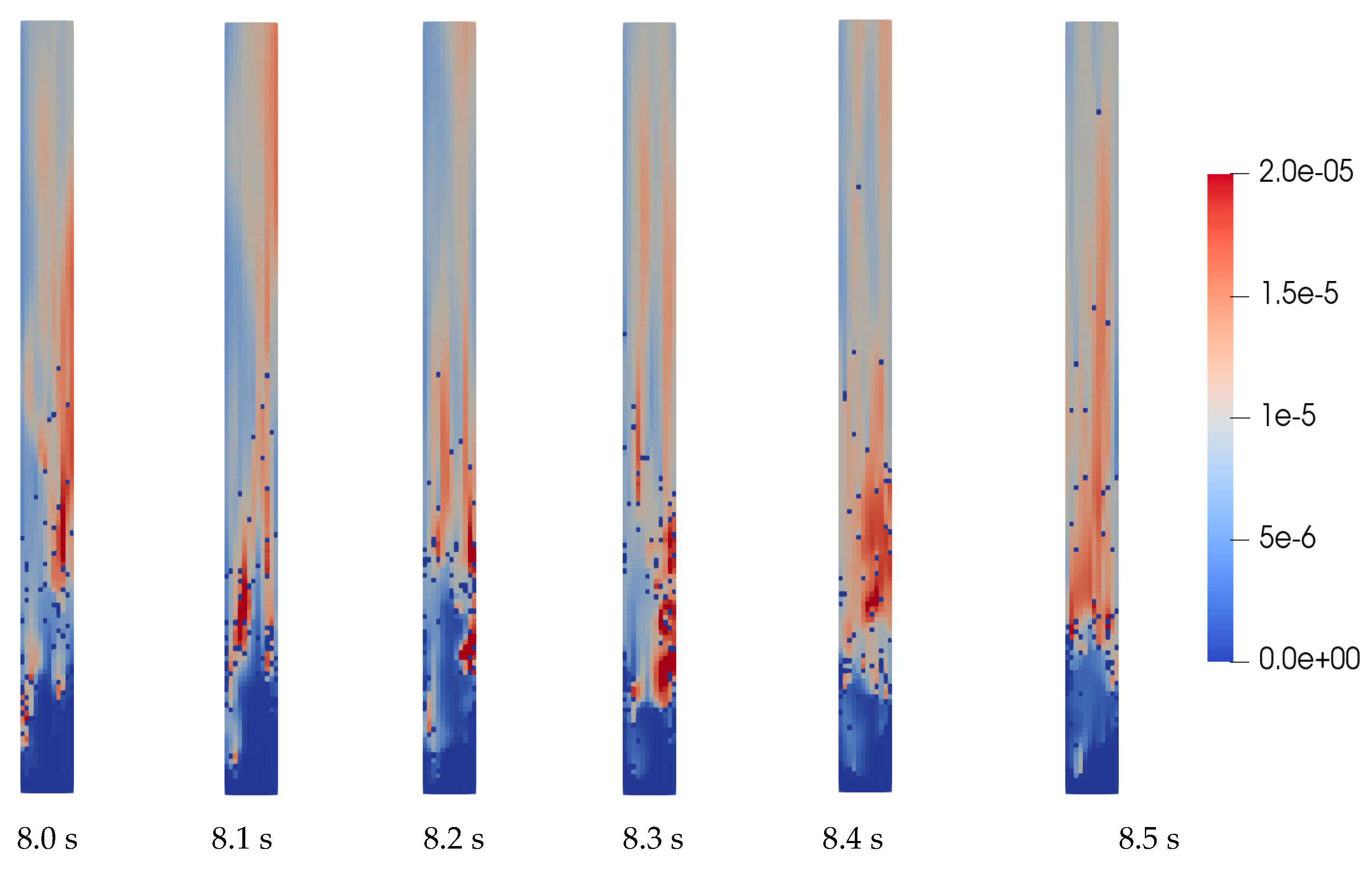
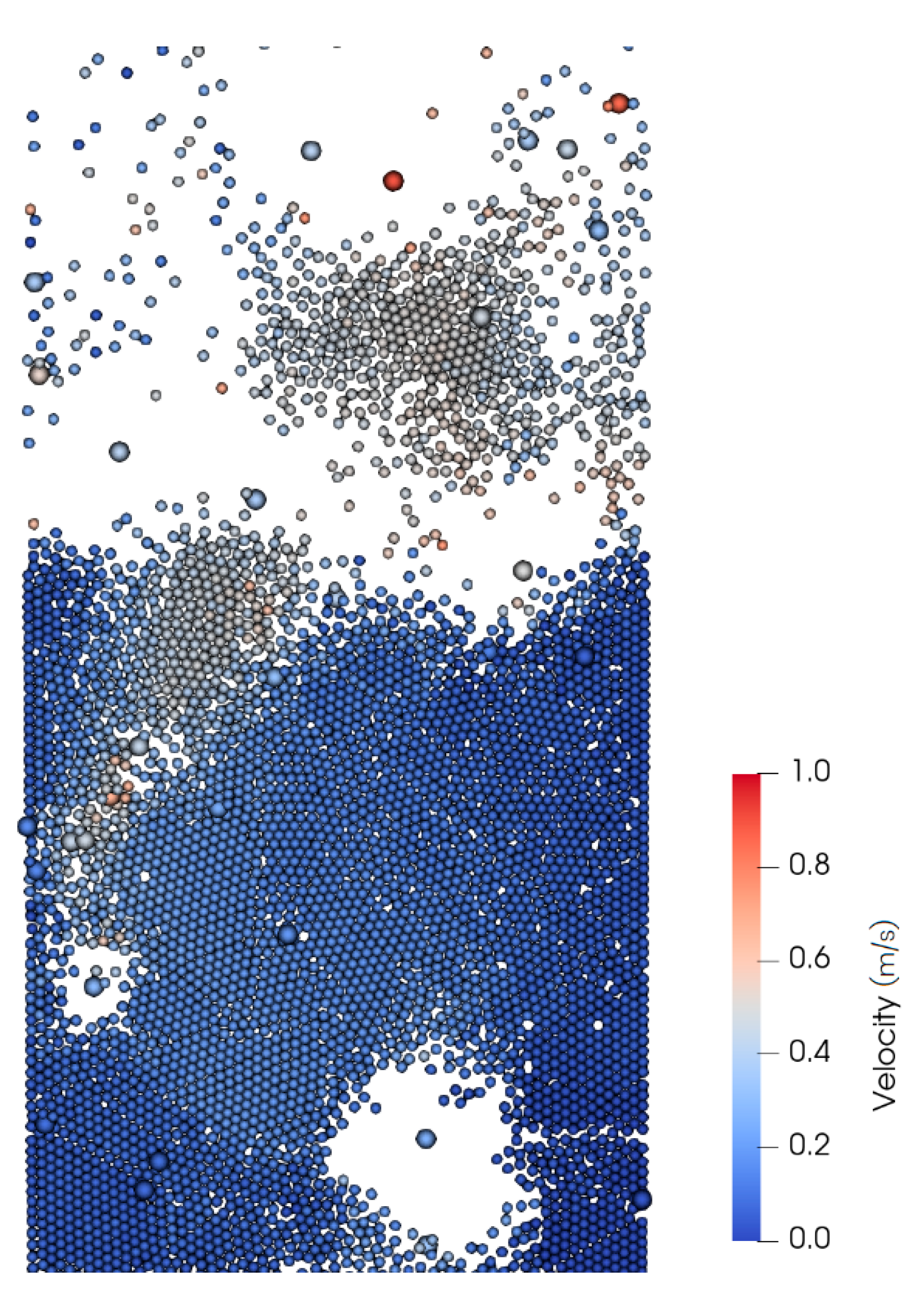

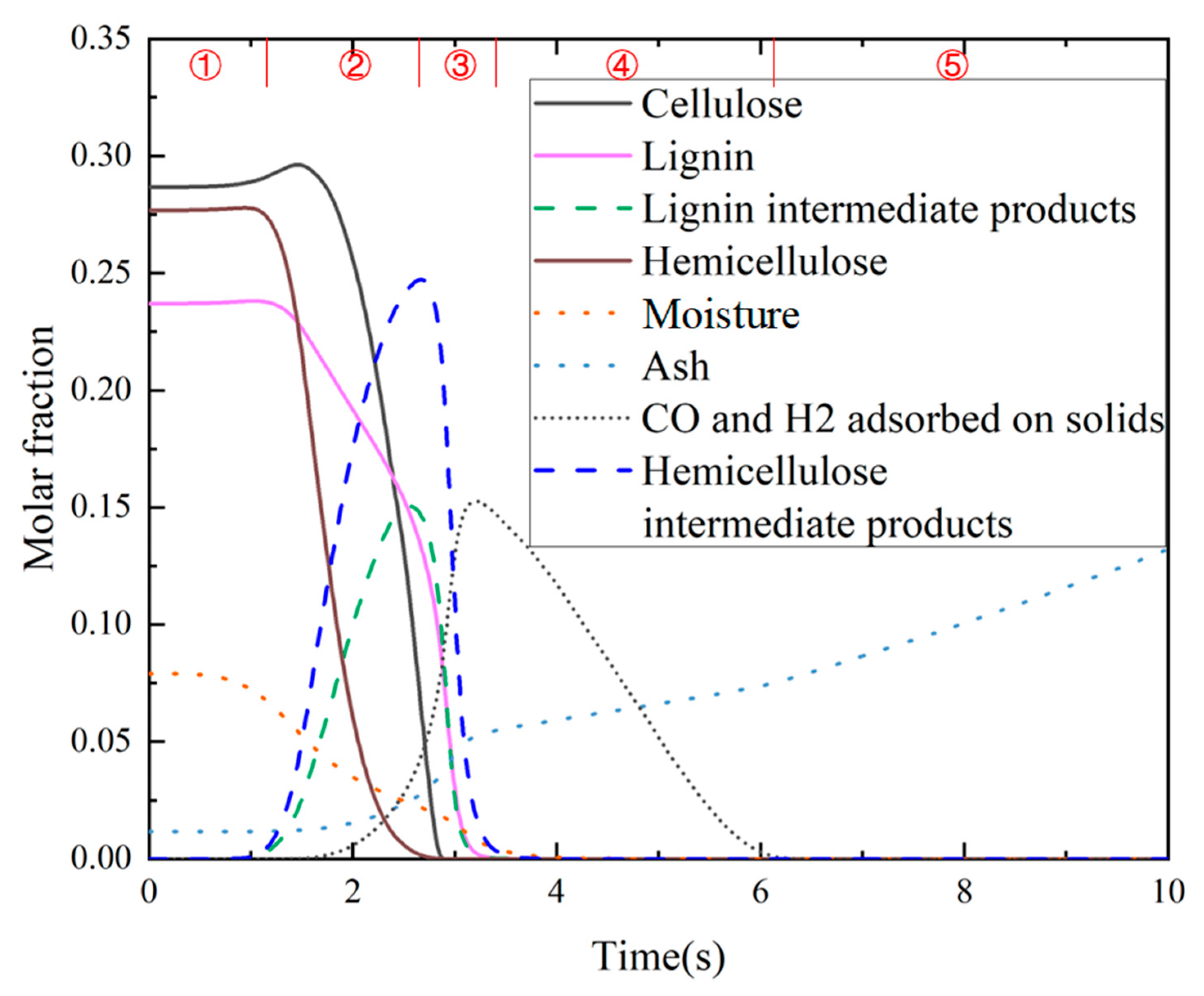
| No. | Chemical Equation | k (1/s) | E (Cal/mol) |
|---|---|---|---|
| 1 | CO + H2O↔CO2 + H2 | Ref. [4] | |
| 2 | CH4 + H2O→CO + 3*H2 | Ref. [4] | |
| 3 | Char + CO2→2*CO | Ref. [4] | |
| 4 | Char + H2O→CO + H2 | Ref. [4] | |
| 5 | Cellulose→Active Cellulose | 1.50 × 1014 | 4.70 × 104 |
| 6 | Active Cellulose→0.05*CH2OHCH2CHO + 0.4*CH2OHCHO + 0.03*CHOCHO + 0.17*CH3CHO + 0.25*C6H6O3 + 0.35*C2H5CHO + 0.2*CH3OH + 0.15*CH2O + 0.49*CO + 0.43*CO2 + 0.13*H2 + 0.93*H2O + 0.02*HCOOH + 0.05*CH4 + 0.66*CHAR + 0.05*G_CO + 0.05*G_CO_H2_L + 0.1*G_H2 | 2.50 × 106 | 1.91 × 104 |
| 7 | Active Cellulose→C6H10O5 | 3.30 × T | 1.00 × 104 |
| 8 | Cellulose→0.125*H2 + 4.45*H2O + 5.45*CHAR + 0.12*G_CO_H2_S + 0.25*G_CO + 0.18*G_CO_H2_L + 0.125*G_H2 | 9.00 × 107 | 3.10 × 104 |
| 9 | GMSW_C5H8O4→0.7*HCE1_C5H8O4 + 0.3*HCE2_C5H8O4 | 1.00 × 1010 | 3.10 × 104 |
| 10 | XYHW_C5H8O4→0.35*HCE1_C5H8O4 + 0.65*HCE2_C5H8O4 | 1.25 × 1011 | 3.14 × 104 |
| 11 | XYGR_C5H8O4→0.12*HCE1_C5H8O4 + 0.88*HCE2_C5H8O4 | 1.25 × 1011 | 3.00 × 104 |
| 12 | HCE1_C5H8O4→0.06*CH2OHCH2CHO + 0.16*FURFURAL_C5H4O2 + 0.1*CHOCHO + 0.13*C6H6O3 + 0.09*CO2 + 0.02*H2 + 0.1*CHAR + 0.54*H2O + 0.25*C6H10O5 + 0.1*CH4 + 0.25*C5H8O4 | 16.0 × T | 1.29 × 104 |
| 13 | HCE1_C5H8O4→0.4*CH2O + 0.49*CO + 0.39*CO2 + 0.1*H2 + 0.4*H2O + 0.975*CHAR + 0.05*HCOOH + 0.175*C2H4 + 0.625*CH4 + 0.37*G_CO_H2_S + 0.51*G_CO2 + 0.01*G_CO + 0.43*G_CO_H2_L + 0.05*G_H2 + 0.2*G_C2H6 | 3.0 × 10−3 × T | 3.60 × 103 |
| 14 | HCE2_C5H8O4→0.145*FURFURAL_C5H4O2 + 0.105*CH3CO2H + 0.035*CH2OHCHO + 0.3*CO + 0.5125* CO2 + 0.5505* H2 + 0.056* H2O + 0.2395*CH4 + 0.0175*HCOOH + 0.049*C2H5OH + 0.7125*CHAR + 0.45*G_CO2 + 0.78*G_CO_H2_S + 0.105*G_CH3OH + 0.1*C2H4 + 0.18* G_CO_H2_L + 0.21*G_H2 + 0.2*G_C2H6 | 7.0 × 109 | 3.05 × 104 |
| 15 | LIGH_C22H28O9→0.2*CH2OHCHO + 0.5*C2H5CHO + 0.1*CO + 0.4*C2H4 + 0.1*C2H6 + LIGOH_C19H22O8 | 6.70 × 1012 | 3.75 × 104 |
| 16 | LIGO_C20H22O10→CO2 + LIGOH-C19H22O8 | 3.30 × 108 | 2.55 × 104 |
| 17 | LIGC_C15H14O4→0.1*C6H5OCH3 +0.22*CH2O +0.21*CO + 0.1*CO2 +0.27*C2H4+ 0.2*G_C2H6 + 0.1*VANILLIN_C8H8O3 + 0.35*LIGCC_C15H14O4 + 5.85*CHAR + 0.4*G_CO_H2_S + 0.36*CH4 + 0.17*G_CO_H2_L + H2O + 0.1*G_H2 | 1.00 × 1011 | 3.72 × 104 |
| 18 | LIGCC_C15H14O4→0.15*C6H5OCH3 +0.35* CH2OHCHO + 1.15*CO +0.7*H2 + 0.7*H2O + 0.45*CH4 + 0.25*VANILLIN_C8H8O3 + 0.15*CRESOL_C7H8O + 0.4*C2H6 + 6.8*CHAR + 0.3*C2H4 + 0.4*G_CO | 1.00 × 104 | 2.48 × 104 |
| 19 | LIGOH-C19H22O8→0.025*C24H28O4 + 0.1*C2H3CHO + 0.6*CH3OH + 0.65*CO + 0.6*G_CO + H2O + 0.05*HCOOH + 0.35*CH4 + 4.25*CHAR + 0.05*CO2 + 0.9*LIG_C11H12O4 + 0.1*C2H4 + 0.45*G_CO_H2_L + 0.3*G_CH3OH + 0.15*G_C2H6 + 0.4*G_CO_H2_S | 1.50 × 108 | 3.00 × 104 |
| 20 | LIG_C11H12O4→0.1*C6H5OCH3 + 0.3*CH3CHO + 0.6*CO + 0.5*C2H4 + VANILLIN_C8H8O3 + 0.1*CHAR | 4.00 × T | 1.20 × 104 |
| 21 | LIG_C11H12O4→0.4*CH2O + 0.3*CO + 0.6*H2O + 0.6*CH4 + 6.1*CHAR + 0.1*CO2 + 0.65*G_CO_H2_S + 0.2*G_CO + 0.4*G_CH3OH + 0.5*C2H4 + 1.25* G_CO_H2_L + 0.1*G_H2 | 0.083 × T | 0.80 × 104 |
| 22 | LIG_C11H12O4→0.4*CH3OH + 0.4*CH2O + 2.6*CO + 0.6*H2O + 0.75* C2H4 + 0.6*CH4 + 0.5*C2H6 + 4.5*CHAR | 1.50 × 109 | 3.15 × 104 |
| 23 | TGL_C57H10O7→C2H3CHO + 0.5*C13H22O2 + 2.5*C19H34O2 | 7.00 × 1012 | 4.57 × 104 |
| 24 | TANN_C15H12O7→H20 + 0.85*C6H5OH + ITANN_C8H4O4 + G_CO + 0.15*G_C6H5OH | 2.00 × 101 | 1.00 × 104 |
| 25 | ITANN_C8H4O4→2*CO + H2O + 5*CHAR + 0.45*G_CO_H2_S + 0.55*G_CO_H2_L | 1.00 × 103 | 2.50 × 104 |
| 26 | G_CO2→CO2 | 1.00 × 10⁶ | 2.45 × 104 |
| 27 | G_CO→CO | 5.00 × 1012 | 5.25 × 104 |
| 28 | G_CH3OH→CH3OH | 2.00 × 1012 | 5.00 × 104 |
| 29 | G_CO_H2_L→0.2*CO + 0.2*H2 + 0.8*H2O + 0.8*CHAR | 6.00 × 1010 | 5.00 × 104 |
| 30 | G_C2H6→C2H6 | 1.00 × 1011 | 5.20 × 104 |
| 31 | G_CH4→CH4 | 1.00 × 1011 | 5.30 × 104 |
| 32 | G_C2H4→C2H4 | 1.00 × 1011 | 5.40 × 104 |
| 33 | G_C6H5OH→C6H5OH | 1.50 × 1012 | 5.50 × 104 |
| 34 | G_CO_H2_S→0.8*CO + 0.8*H2 + 0.2*H2O + 0.2*CHAR | 1.00 × 109 | 5.90 × 104 |
| 35 | G_H2→H2 | 1.00 × 108 | 7.00 × 104 |
| 36 | MOISTURE→H2O | T | 0.80 × 104 |
| No. | Distinguished Name | Substance | Molecular Weight | Hf/R |
|---|---|---|---|---|
| 1 | CH2O | Methanal | 28.0538 | 6314.2627 |
| 2 | C2H3CHO | Acrolein | 56.0642 | −7941.6205 |
| 3 | C2H5CHO | Propionaldehyde | 58.0800 | −22,268.8471 |
| 4 | C2H5OH | Ethanol | 46.0690 | −28,257.8290 |
| 5 | C5H8O4 | Glutaric acid | 132.1161 | −76,265.7276 |
| 6 | C6H10O5 | Levoglucosan | 162.1424 | −101,107.1970 |
| 7 | C6H5OCH3 | Anisole | 108.1399 | −8605.9386 |
| 8 | C6H5OH | Phenol | 94.1130 | −11,594.1217 |
| 9 | C6H6O3 | Pyrogallol | 126.1118 | −40,161.0469 |
| 10 | C24H28O4 | Aromatic dimer | 380.4839 | −123.721175 |
| 11 | CH2OHCH2CHO | 3-hydroxypropanal | 74.07944 | −40,412.6826 |
| 12 | CH2OHCHO | Ethanol aldehyde | 60.05256 | −36,869.6787 |
| 13 | CH3CHO | Acetaldehyde | 44.05316 | −19,987.9484 |
| 14 | CH3CO2H | Acetic acid | 60.05256 | −51,987.3138 |
| 15 | CH3OH | Methanol | 32.04216 | −24,174.6056 |
| 16 | CHOCHO | Glyoxal | 58.03668 | −25,507.4563 |
| 17 | CRESOL_C7H8O | Cresol | 108.1399 | −15,485.6569 |
| 18 | FURFURAL_C5H4O2 | Furfural | 96.08556 | −18,188.2234 |
| 19 | VANILLIN_C8H8O3 | Vanillin | 152.1497 | −44,656.4291 |
| Product | Experiment | DEM (Single-Step) | DEM (Semi-Detailed) | |
|---|---|---|---|---|
| Gas | CO (Vol%) | 33.2 | 32.9 | 24.8 |
| CO2 (Vol%) | 11.7 | 12.9 | 21.0 | |
| H2 (Vol%) | 43.6 | 43.2 | 45.0 | |
| CH4 (Vol%) | 11.5 | 11.0 | 9.2 | |
| LHV of the gas (kJ/Nm3) | 13,018 | 12,764 | 10,873 | |
| Tar (g/Nm3) | 43 | — | 116 | |
| Char (g/kg) | 102 | — | 75.4 | |
| Reaction Number | 630 °C | 770 °C |
|---|---|---|
| 1 | 86.38% | 107.30% |
| 2 | 38.63% | 277.62% |
| 3 | 106.88% | 127.02% |
| 4 | 53.33% | 207.19% |
| 5 | 114.91% | 64.58% |
| 6 | 125.50% | 57.15% |
| 7 | 113.75% | 65.10% |
| 8 | 144.22% | 48.77% |
| 9 | 24.45% | 346.34% |
| 10 | 175.27% | 37.34% |
| 11 | 25.65% | 346.11% |
| 12 | 165.72% | 43.09% |
| 13 | 30.61% | 242.04% |
| 14 | 128.09% | 64.51% |
| 15 | 142.18% | 48.33% |
| 16 | 141.55% | 54.21% |
| 17 | 185.43% | 56.76% |
| 18 | 145.25% | 130.47% |
| 19 | 124.37% | 65.22% |
| 20 | 143.41% | 53.49% |
| 21 | 148.36% | 51.09% |
| 22 | 122.88% | 66.25% |
| 23 | 11.19% | 307.30% |
| 24 | 66.64% | 265.41% |
| 25 | 30.41% | 342.13% |
| 26 | 124.64% | 69.76% |
| 27 | 112.98% | 118.91% |
| 28 | 44.11% | 200.22% |
| 29 | 116.17% | 84.81% |
| 30 | 151.86% | 77.21% |
| 31 | 8.43% | 280.57% |
| 32 | 8.02% | 275.41% |
| 33 | 7.62% | 270.17% |
| 34 | 196.07% | 53.30% |
| 35 | 4.04% | 148.89% |
| 36 | 146.09% | 58.86% |
Disclaimer/Publisher’s Note: The statements, opinions and data contained in all publications are solely those of the individual author(s) and contributor(s) and not of MDPI and/or the editor(s). MDPI and/or the editor(s) disclaim responsibility for any injury to people or property resulting from any ideas, methods, instructions or products referred to in the content. |
© 2025 by the authors. Licensee MDPI, Basel, Switzerland. This article is an open access article distributed under the terms and conditions of the Creative Commons Attribution (CC BY) license (https://creativecommons.org/licenses/by/4.0/).
Share and Cite
Ding, S.; Wu, Y.; Yang, X.; Zhang, Z. Numerical Investigation of Tar Formation Mechanisms in Biomass Pyrolysis. Aerospace 2025, 12, 477. https://doi.org/10.3390/aerospace12060477
Ding S, Wu Y, Yang X, Zhang Z. Numerical Investigation of Tar Formation Mechanisms in Biomass Pyrolysis. Aerospace. 2025; 12(6):477. https://doi.org/10.3390/aerospace12060477
Chicago/Turabian StyleDing, Shuiting, Yifei Wu, Xiaojun Yang, and Zongwei Zhang. 2025. "Numerical Investigation of Tar Formation Mechanisms in Biomass Pyrolysis" Aerospace 12, no. 6: 477. https://doi.org/10.3390/aerospace12060477
APA StyleDing, S., Wu, Y., Yang, X., & Zhang, Z. (2025). Numerical Investigation of Tar Formation Mechanisms in Biomass Pyrolysis. Aerospace, 12(6), 477. https://doi.org/10.3390/aerospace12060477







